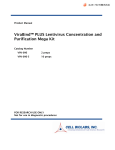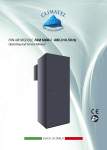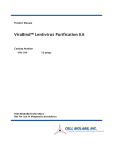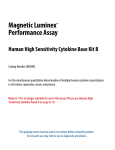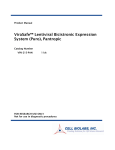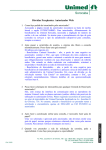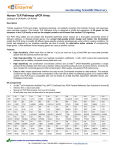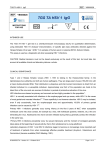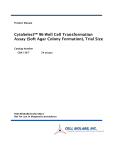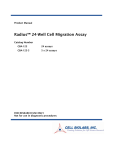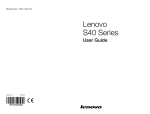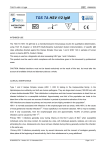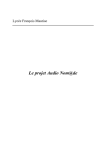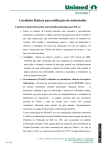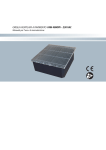Download QuickTiter™ Lentivirus Quantitation Kit
Transcript
Product Manual QuickTiter™ Lentivirus Quantitation Kit Catalog Number VPK-112 20 assays FOR RESEARCH USE ONLY Not for use in diagnostic procedures Introduction Lentivirus vector based on the human immunodeficiency virus-1 (HIV-1) has become a promising vector for gene transfer studies. The advantageous feature of lentivirus vector is the ability of gene transfer and integration into dividing and non-dividing cells. The pseudotyped envelope with vesicular stomatitis virus envelope G (VSV-G) protein broadens the target cell range. Lentiviral vectors have been shown to deliver genes to neurons, lymphocytes and macrophages, cell types that previous retrovirus vectors could not be used. Lentiviral vectors have also proven to be effective in transducing brain, liver, muscle, and retina in vivo without toxicity or immune responses. Recently, the lentivirus system is widely used to integrate siRNA efficiently in a wide variety of cell lines and primary cells both in vitro and in vivo. Lentivirus particles are produced from 293T cells through transient transfection of 3 or 4 plasmids that encodes for the components of the virion. Viral medium containing viral particles produced by packaging cells within 48-72 hr can be harvested. To ensure that pseudoviral medium is viable, and to control the number of copies of integrated viral constructs per target cell, the viral titer needs to be determined before proceeding with transduction experiments. Viral titer can be determined by transduction of HT-1080 or Hela cells, and followed by antibiotic selection of stable clones. However, it takes weeks to generate sizable stable cell colonies for counting and calculating the titer results. Cell Biolabs’ proprietary QuickTiter™ Lentiviral Quantitation Kit does not involve cell infection; instead it specifically measures the viral nucleic acid content of purified viruses or unpurified viral supernatant sample (See Test Principle). In the case of unpurified viral supernatant, the kit is especially useful for determining the supernatant titer before the transduction step. The kit has detection sensitivity limit of 1 X 1010 VP/mL, which is sufficient for mid or high-titer lentivirus sample. The entire procedure takes about 45 to 60 minutes. Each kit provides sufficient reagents to perform up 20 tests for viral samples and controls. QuickTiter™ Lentiviral Quantitation Kit provides an efficient system for rapid quantitation of lentivirus titer for both viral supernatant and purified virus. The system may be adapted to quantitation of other viral types, such as retrovirus and adenovirus. 2 Assay Principle 3 Related Products 1. LTV-100: 293LTV Cell Line 2. LTV-200: ViraDuctin™ Lentivirus Transduction Kit 3. LTV-300: GFP Lentivirus Control 4. VPK-104: ViraBind™ Lentivirus Purification Kit 5. VPK-107: QuickTiter™ Lentivirus Titer Kit (Lentivirus-Associated HIV p24) 6. VPK-108-H: QuickTiter™ Lentivirus Quantitation Kit (HIV p24 ELISA) 7. VPK-211-PAN: ViraSafe™ Universal Lentivirus Expression System 8. VPK-211: pSMPUW Universal Lentiviral Expression Vector (Promoterless) Kit Components 1. QuickTiter™ Solution A (Part No. 90020): One tube – 200 µL. 2. QuickTiter™ Lentivirus Capture Solution (Part No. 90026): One tube – 1.0 mL. 3. QuickTiter™ Solution B (10X) (Part No. 90022): Two tubes – 1.8 mL each. 4. QuickTiter™ Solution C (2X) (Part No. 90023): Two tubes – 1.5 mL each 5. CyQuant® GR Dye (400X) (Part No. 105101): One tube – 50 µL. 6. QuickTiter™ Lentivirus RNA Standard (Part No. 90027): One tube – 500 µL containing 200 µg/mL Lentivirus RNA Standard Materials Not Supplied 1. Lentiviral Sample: purified virus or unpurified viral supernatant 2. Cell Culture Centrifuge 3. 0.45 µm filter 4. 1X PBS containing 10 mM MgCl2, 1 mM CaCl2 5. 1X TE (10 mM Tris, pH 7.5, 1 mM EDTA) 6. Fluorescence Plate Reader Storage Store all kit components at 4ºC until their expiration dates. Safety Considerations Remember that you will be working with samples containing infectious virus. Follow the recommended NIH guidelines for all materials containing BSL-2 organisms. 4 Preparation of Reagents 1X QuickTiter™ Solution B: Prepare a 1X QuickTiter™ Solution B by diluting the provided 10X stock 1:10 in deionized water. Store the diluted solution at room temperature. 1X QuickTiter™ Solution C: Prepare a 1X QuickTiter™ Solution C by diluting the provided 2X stock 1:2 in deionized water. Store the diluted solution at room temperature. 1X CyQuant® GR Dye: Estimate the amount of 1X CyQuant® GR Dye needed based on the number of assays including lentivirus RNA standard samples. Immediately before use, prepare a 1X CyQuant® GR Dye by diluting the provided 400X stock 1:400 in 1X TE. For best results, the diluted solution should be used with 2 hrs of its preparation. Preparation of Standard Curve 1. To create lentivirus RNA standards from 200 µg/mL, 100 µg/mL, 50 µg/mL, 25 µg/mL,… 0 µg/mL (1:2 serial dilution), label nine microcentrifuge tubes #1 to #9. 2. Add 20 µL of 1X QuickTiter™ Solution C to tube #2 to #9, transfer 20 µL of 200 µg/mL QuickTiter™ Lentivirus RNA Standard to tube #1 and #2. Mix tube #2 well, transfer 20 µL of the mixture (100 µg/mL) to the next tube. Repeat the steps through tube #8 and use tube #9 as a blank. 3. Transfer 5 µL of each dilution including blank to a microtiter plate suitable for fluorometer. Add 95 µL of 1X CyQuant® GR Dye to each of the wells containing the 5 µL sample. Read the plate with a fluorescence plate reader using a 480/520 nm filter set. Pseudovirus Production The following procedure is suggested for a 10cm dish and may be optimized to suit individual needs. Please refer to the user manual when the lentivirus expression systems from Invitrogen or System Biosciences is used. 1. Use HEK 293T cells that have been passaged 2-3 times prior to transfection. Culture these cells until the monolayer is 70-80% confluent. 2. Replace the cell culture media with new growth media, 10 mL per 10 cm dish. 3. Transfect cells with packaging plasmid mix and your expression construct. Lipofectamine™, please refer to Invitrogen’s Lipofectamine™ reagent manual. When use 4. After 48 hrs, harvest all 10 mL medium in a 15 mL conical tube and centrifuge for 5 min at 3000 rpm to pellet the cell debris. Filter the supernatant through a 0.45 µm low protein binding filter. 5. To concentrate the viral supernatant, spin at 50,000 g for 1 hr and resuspend the viral pellet in culture medium. 6. The concentrated viral supernatant can be immediately tittered or stored at -80ºC. Note: Freezing and thawing may result in 2-3 fold loss of viral titer after each cycle. Assay Protocol 1. Add viral sample (1 to 500 µL) to a 1.5 mL microcentrifuge tube and adjust the final volume to 1 mL with 1X PBS containing 10 mM MgCl2, 1 mM CaCl2. 5 Note: A proper negative control MUST be included for accurate quantitation. For purified viral sample, viral storage buffer is suggested. For unpurified viral supernatant, use the same volume of untransfected or mock transfected 293T culture medium supernatant. 2. Add 10 µl of QuickTiter™ Solution A to the assay tube and mix by inverting the tube several times. Incubate at 37ºC for 30 minutes. 3. Mix the QuickTiter™ Lentivirus Capture Solution by vortexing for 10 seconds. Quickly transfer 40 µL of the bead capture solution to the assay tube containing the viral sample. Incubate at room temperature for 10 min on an orbital shaker. 4. Spin down the beads at 2000X g for 30 seconds. Discard the supernatant and wash the beads with 750 µL of 1X QuickTiter™ Solution B. Mix by inverting the tube several times, spin down the beads and discard the supernatant. 5. Repeat the wash step once and aspirate the final wash. To remove the last bit of liquid, centrifuge the tube again at 2000X g for 30 seconds, and remove remaining supernatant with a small bore pipette tip to avoid aspirating the beads. 6. Add 20 µL of 1X QuickTiter™ Solution C, mix with the beads by vortexing for 10 seconds, spin down the beads at 12000g for 30 seconds. 7. Transfer 5 µL supernatant to a microtiter plate suitable for fluorometer. Add 95 µL of freshly prepared 1X CyQuant® GR Dye to well(s) containing the 5 µL supernatant. Read the plate with a fluorescence plate reader using a 480/520 nm filter set. 8. Calculate lentivirus virus titer based on the standard curve. Example of Results The following figures demonstrate typical quantitation results. One should use the data below for reference only. This data should not be used to interpret actual results. 6 80 500 70 RFU (520 nm) RFU (520 nm) 400 300 200 100 60 50 40 30 20 10 0 0 0 400 800 0 1200 Lentiviral RNA (ng) 50 100 150 Lentiviral RNA (ng) Figure 1: Lentivirus RNA Standard Curve. The QuickTiter™ Lentivirus RNA Standard was diluted as described in the above instructions. Fluorescence measurement was performed on SpectraMax Gemini XS Fluorometer (Molecular Devices) with a 485/538 nm filter set and 530 nm cutoff. Calculation of Lentivirus Titer (VP/mL) 1. Determine Viral RNA amount: 1) Calculate Net RFU (Relative Fluorescence Unit): Net RFU = RFU (viral sample) – RFU (negative control corresponding to viral sample) 2) Use the standard curve to determine the viral RNA amount of each unknown sample. 2. Calculate Viral Titer: The average genome size of lentivirus is 8 kbp, therefore, 1 ng lentiviral RNA = (1x10-9) g / (8,000 bp x 660 g/bp) X 6 x 1023 = 1.1 x 108 VP Virus Titer (VP/mL) = Amount of lentiviral RNA (ng) X 1.1 x 108 VP X (20 µL/5 µL) Viral sample volume (mL) Virus Titer (VP/mL) = Amount of lentiviral RNA (ng) X 4.4 x 108 VP/ng Viral sample volume (mL) Examples of GFP lentivirus Titer Quantitation: Method: 293T cells were transfected with GFP lentiviral expression construct and packaging plasmid mix. Medium containing pseudotyped lentivirus was harvested and filtered after 48 hr. The supernatant was then spun at 50,000 g for 1 hr to concentrate 20-fold. The concentrated lentiviral supernatant titer was determined as described in assay instructions. Lentiviral Supernatant: 500 µL was used Average Net RFU = 96 - 11 = 85 RFU or 152 ng of viral RNA Virus Titer (VP/mL) = 152 (ng) X 4.4 x 108 VP/ng = 1.3 X 1011 VP/mL 0.5 mL 7 Note: The calculated result is the lentivirus physical titer, and it is NOT the infectious titer (TU/mL). The relatively large difference between the infectious titer and physical titer (Viral Particles or RNA Molecules/mL) is derived from the large number of defective particles generated during the production process. When the infectious titer is determined, the results vary among different target cell lines or transduction methods. References 1. Naldini, L., U. Blomer, P. Gallay, D. Ory, R. Mulligan, F. H. Gage, I. M. Verma, and D. Trono (1996) Science 272, 263-267. 2. Verma, I. M., and N. Somia (1997) Nature 389, 239-242 3. Kafri, T., U. Blomer, D. A. Peterson, F. H. Gage, and I. M. Verma (1997) Nat. Genet. 17, 314-317. 4. Beyer, W. R., M. Westphal, W. Ostertag, and D. von Laer (2002) J. Virol. 76, 1488-1495. Recent Product Citations 1. Lambert, M. P. et al. (2015). Intramedullary megakaryocytes internalize released platelet factor 4 (PF4) and store it in alpha granules. J Thromb Haemost. doi:10.1111/jth.13069. 2. Kim, H. Suk. et al. (2015). APE1, the DNA base excision repair protein, regulates the removal of platinum adducts in sensory neuronal cultures by NER.Mutat Res-Fund Mol M. doi:10.1016/j.mrfmmm.2015.06.010. 3. Yadavilli, S. et al. (2015). The emerging role of NG2 in pediatric diffuse intrinsic pontine glioma. Oncotarget. 6:12141-12155. 4. Ahmad, M. A. et al. (2015). Label-free capacitance-based identification of viruses. Sci Rep. 5:9809. 5. Tang, X. et al. (2015). The advantages of PD1 activating chimeric receptor (PD1-ACR) engineered lymphocytes for PDL1+ cancer therapy. Am J Transl Res. 7:460-473. 6. Giraldo, D. M. et al. (2015). Impact of in vitro costimulation with TLR2, TLR4 and TLR9 agonists and HIV-1 on antigen-presenting cell activation. Intervirology. 58:122-129. 7. Shin, H. S. et al. (2015). Crosstalk among IL-23 and DNAX activating protein of 12 kDa– dependent pathways promotes osteoclastogenesis. J Immunol. 194:316-324. 8. Al Ahmad, M. et al. (2014). Virus detection and quantification using electrical parameters. Sci Rep. 4:6831. 9. Fan, X. et al. (2014). Endometrial VEGF induces placental sFLT1 and leads to pregnancy complications. J Clin Invest. 124:4941-4952. 10. Zhao, S. L. et al. (2014). Mesenchymal stem cells with overexpression of midkine enhance cell survival and attenuate cardiac dysfunction in a rat model of myocardial infarction. Stem Cell Res Ther. 5:37. 11. Rossello, R.A. et al. (2013). Mammalian genes induce partially reprogrammed pluripotent stem cells in non-mammalian vertebrate and invertebrate species. eLife Sci. 2:e00036. 12. Fan, X. et al. (2012). Transient, inducible, placenta-specific gene expression in mice. Endocrinology. 153: 5637-5644. 8 13. Veeraraghavalu, K. et al. (2010). Presenilin 1 mutants impair the self-renewal and differentiation of adult murine subventricular zone-neuronal progenitors via cell-autonomous mechanisms involving notch signaling. J. Neurosci. 30:6903-6915. 14. Niwano, K. et al. (2008). Lentiviral vector-mediated SERCA2 gene transfer protects against heart failure and left ventricular remodeling after myocardial infarction in rats. Mol. Ther. 16:1026-1032. License Information This product is provided under an intellectual property license from Life Technologies Corporation. The purchase of this product conveys to the buyer the non-transferable right to use the purchased product and components of the product only in research conducted by the buyer (whether the buyer is an academic or for-profit entity). The sale of this product is expressly conditioned on the buyer not using the product or its components, or any materials made using the product or its components, in any activity to generate revenue, which may include, but is not limited to use of the product or its components: (i) in manufacturing; (ii) to provide a service, information, or data in return for payment; (iii) for therapeutic, diagnostic or prophylactic purposes; or (iv) for resale, regardless of whether they are resold for use in research. For information on purchasing a license to this product for purposes other than as described above, contact Life Technologies Corporation, 5791 Van Allen Way, Carlsbad CA 92008 USA or [email protected]. Warranty These products are warranted to perform as described in their labeling and in Cell Biolabs literature when used in accordance with their instructions. THERE ARE NO WARRANTIES THAT EXTEND BEYOND THIS EXPRESSED WARRANTY AND CELL BIOLABS DISCLAIMS ANY IMPLIED WARRANTY OF MERCHANTABILITY OR WARRANTY OF FITNESS FOR PARTICULAR PURPOSE. CELL BIOLABS’ sole obligation and purchaser’s exclusive remedy for breach of this warranty shall be, at the option of CELL BIOLABS, to repair or replace the products. In no event shall CELL BIOLABS be liable for any proximate, incidental or consequential damages in connection with the products. Contact Information Cell Biolabs, Inc. 7758 Arjons Drive San Diego, CA 92126 Worldwide: +1 858-271-6500 USA Toll-Free: 1-888-CBL-0505 E-mail: [email protected] www.cellbiolabs.com 2004-2015: Cell Biolabs, Inc. - All rights reserved. No part of these works may be reproduced in any form without permissions in writing. 9









